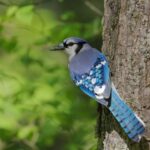By Adam Willis, Seasonal Naturalist
 Look at this blue jay. What color do you see?
Look at this blue jay. What color do you see?
I’m sure that you’d tell me with absolute certainty that it’s blue. You can see its blue feathers with your own eyes; you can see the blue tuft atop its head. It’s an indisputable fact. It’s even in their name: blue jay. However, what if I was to claim that your eyes were lying to you? A large portion of the animal kingdom tricks our eyes on the regular with a phenomenon called structural coloration. Instead of creating specific pigments of their vibrant colors, some animals—like birds, butterflies, reptiles, and fish—utilize physics to appear blue when they actually aren’t.
To follow our example, let’s discuss the blue jay. It’s known that blue jays have specialized structures in their wings that scatter light similar to a prism. If you were to observe the microscopic anatomy of a blue jay feather, you would see a series of nanostructures composed of air and keratin. These structures are layered directly on top of melanocytes—cells that produce a brown pigment. When light passes through the nanostructure, it gets split into its basic components. Every color is absorbed by the melanin except for blue, which is reflected outward. This blue light hits our eyes and tells our brain we’re seeing blue; however, if you were to grind up a blue jay feather, you wouldn’t have a blue powder—it would actually be brown. There’s no pigment making the feathers blue.
Countless animals appear blue because of similar anatomical structures. Bluebirds, Hyacinth macaws, and Indigo buntings all have similar nanostructures in their feathers. Morpho butterflies have microscopic ridges in their scales that make their wings look iridescent blue. Blue-ringed octopuses and Blue tangs create nanostructures by expanding and contracting their chromatophores—melanin cells that can shrink and grow. Green-colored reptiles have nanostructures in their yellow-pigmented scales; the two colors mix and their scales appear green. Even people with blue eyes are being tricked; the protein that makes up the iris reflects blue light just like a blue jay feather—in reality, blue eyes are grey.
So, what conclusion can we get from this fact? Is nature lying to us? Should we distrust our eyes from now on? Personally, I don’t think we should subject ourselves to that self-doubt. Excessively worrying about every detail can cause a great deal of stress on your mind and—by extension—your body. Sure, knowing that our eyes trick us can be confusing. It might even make you existential at times. But if seeing that blue jay tilt its head makes you feel something —excitement, curiosity, joy—you can find peace in the absolute certainty that what you’re seeing is real. It doesn’t matter what something technically is or isn’t—if it makes you happy, that’s all that really matters.






